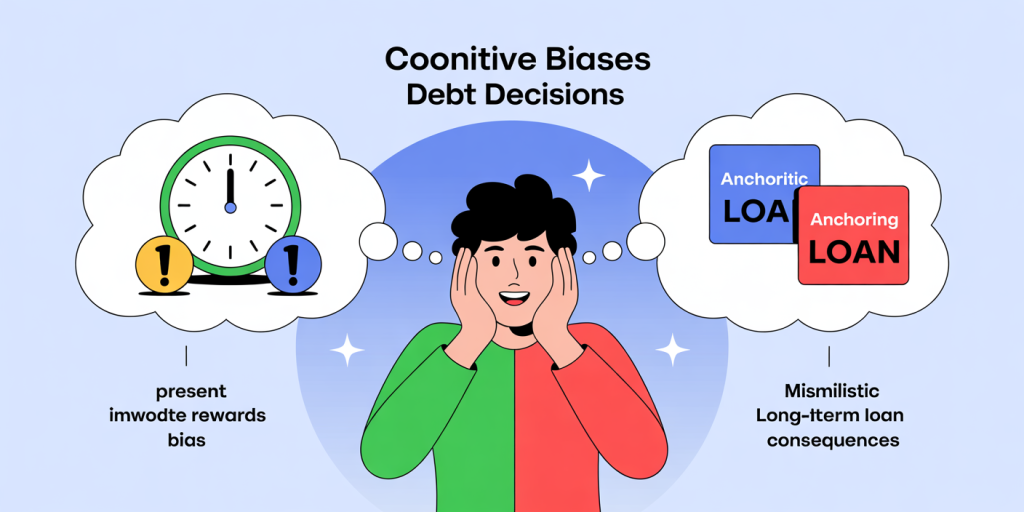Psychology Behind Debt: Why People Stay in Debt and How to Overcome It
Anúncios
Debt is a pervasive issue affecting millions worldwide, impacting not only financial stability but also emotional and psychological well-being. Despite awareness of the negative consequences, many people remain trapped in debt cycles, raising questions about the psychological mechanisms behind this behavior. Understanding why individuals stay in debt and implementing strategies to overcome it involves examining both emotional factors and cognitive biases. This article explores the multifaceted psychology behind debt, offering insights backed by data, real-life examples, and practical approaches for debt management.
Understanding the Emotional Drivers of Debt
Anúncios
Debt is often more than a financial challenge—it’s an emotional burden. People frequently accumulate debt due to stress, social pressures, or as a coping mechanism for negative feelings such as anxiety and depression. For instance, emotional spending, a behavior documented in research such as the 2021 Consumer Financial Protection Bureau (CFPB) report, reveals that about 60% of Americans who overspend cite emotional reasons rather than planned expenditures.
Emotional spending triggers neurological rewards similar to those from gambling or drug use. Dopamine release following purchases creates temporary pleasure, fostering a cycle of impulsive buying despite immediate debt consequences. For example, Jane, a graphic designer from Seattle, shared in a financial advice podcast how shopping helped her feel better during stressful periods, even as her credit card balance soared. This emotional attachment to spending drives many deeper into debt, highlighting the psychological roots beyond mere poor financial choices.

Cognitive Biases and Decision-Making Errors
Beyond emotions, cognitive biases significantly contribute to the persistence of debt. The “present bias” leads people to prioritize immediate rewards over long-term benefits, making it difficult to resist impulse purchases or unnecessary borrowing. According to research published in the *Journal of Economic Psychology*, individuals with stronger present bias are 30% more likely to carry revolving credit card debt.

Another common bias is optimism bias, where debtors underestimate the likelihood of experiencing financial hardships. For example, John, a recent college graduate, believed his income would increase rapidly, justifying substantial student loans alongside credit card debt. Unfortunately, his income stagnated, compounding his financial difficulties.
Additionally, the “anchoring effect” can skew perceptions of affordable debt. When lenders advertise low initial interest rates, borrowers may anchor on this figure and underestimate the actual long-term interest costs. This miscalculation often leads to the continuation of debt beyond manageable limits. Awareness of these cognitive pitfalls is crucial in designing interventions to help people exit debt cycles.
Social and Cultural Influences on Debt Behavior
Debt is also shaped by social and cultural contexts. In consumer-driven societies, social comparison can encourage overspending. Financial psychologist Brad Klontz explains that “keeping up with the Joneses” mentality leads many to borrow money to match peers’ lifestyles, driving sustained debt. This phenomenon is especially pronounced in cultures emphasizing material success as social status.
For example, a 2019 survey by the American Psychological Association found that 45% of respondents reported financial stress relating to societal expectations, with those aged 18-34 being the most affected. Social media exacerbates this issue by constantly displaying curated images of wealth and luxury, pressuring individuals to engage in risky spending behaviors.
Conversely, some cultures have strong taboos against debt, encouraging saving and financial prudence. Comparing countries like Germany, where average household debt-to-income ratios are significantly lower than in the US, illustrates how cultural values impact debt prevalence and attitudes toward borrowing. These insights suggest that addressing debt requires not only individual strategies but also societal shifts in values and expectations.
Psychological Impact of Debt on Mental Health
Chronic debt is closely linked to worsened mental health outcomes. Data from a 2020 study in *The Lancet Psychiatry* indicates that individuals in debt are twice as likely to experience depression and anxiety disorders as those without debt. Financial strain contributes to chronic stress, sleep disorders, and reduced overall life satisfaction.
The case of Sarah, a single mother managing multiple credit card debts, exemplifies this link. Sarah reported feelings of hopelessness and shame, which led to social withdrawal and exacerbated her difficulties in seeking help. This “debt stigma” compounds the psychological toll, often preventing people from discussing their situation or accessing financial counseling services.
Moreover, debt-related stress affects physical health, including increased blood pressure and weakened immunity. This physiological impact creates a feedback loop, where health problems reduce working capacity and exacerbate debt problems. Recognizing debt as a significant mental health concern is crucial for developing holistic approaches to support affected individuals.
Strategies to Overcome Debt: Cognitive and Behavioral Approaches
Effectively overcoming debt necessitates both psychological insight and practical financial measures. Cognitive-behavioral techniques have proven effective in altering debt-related thinking and habits. For instance, Structured Debt Management Programs (DMPs) combine financial planning with psychological support, helping clients reframe their beliefs about money and break negative cycles.
Behavioral strategies such as commitment devices—where individuals restrict access to credit cards or automate payments—help reduce impulsive spending. For example, the “envelope system,” where cash is allocated to specific budget categories, encourages mindful spending and has been endorsed by financial advisors worldwide.
Setting realistic, incremental goals enhances motivation and reduces overwhelm. Highlighting progress, such as paying off a smaller debt first (known as the debt snowball method), provides psychological rewards that reinforce positive behavior. Furthermore, education on financial literacy empowers individuals to make informed decisions and avoid cognitive traps.
A comparative table below summarizes these key approaches:
| Strategy | Description | Psychological Benefit | Practical Outcome |
|---|---|---|---|
| Cognitive Restructuring | Challenging negative beliefs about money | Reduces shame and helplessness | Builds confidence and proactive behavior |
| Commitment Devices | Limiting access to credit or automating payments | Lowers impulsivity | Prevents additional debt accumulation |
| Incremental Goal Setting | Breaking debt repayment into small, achievable steps | Enhances motivation through progress | Maintains engagement and boosts morale |
| Financial Education | Increasing knowledge about budgeting and credit | Improves decision-making | Long-term financial stability |
| Social Support Programs | Group counseling, peer support | Reduces stigma and isolation | Greater adherence to repayment plans |
Case studies from debt counseling organizations report success rates of 60-70% in lowering debt with these combined techniques, emphasizing their practical value.

Future Perspectives: Towards Sustainable Debt Solutions
Addressing the psychology behind debt is increasingly important as consumer credit becomes more accessible and complex. Advances in behavioral economics and digital technology promise more personalized debt management tools. For instance, artificial intelligence-powered financial coaches can tailor interventions based on individual psychological profiles, offering real-time feedback to deter impulsive spending.
Policymakers also have a role in implementing regulatory changes that address cognitive biases, such as clearer disclosure of loan terms and restrictions on predatory lending practices. Increasing financial literacy campaigns in schools and workplaces can create a more informed populace less susceptible to debt traps.
Finally, shifting societal values away from materialism towards financial well-being and mental health can reduce debt-related stigma and encourage more open conversations. Programs integrating mental health support with financial counseling are emerging as effective holistic solutions.
In sum, the future of debt management lies in an integrated approach that combines psychological understanding, technological innovation, policy reform, and cultural change to empower individuals to live debt-free and financially healthy lives.
